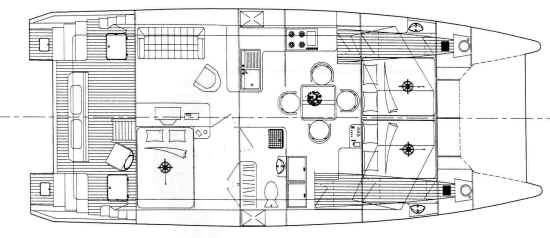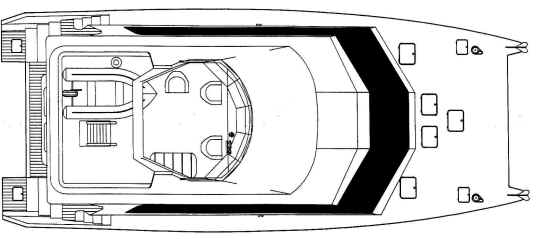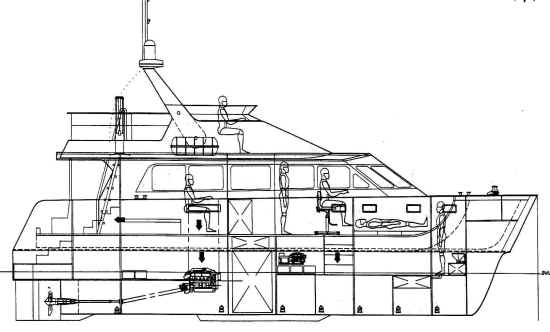Let us custombuild
your dream boat!
Pedigree Cats, Inc.
Malcolm Tennant 44' Power Catamaran
|
|
||
|
|
|
|
|
|
|
|
|
|
|
|
I am often asked "how small" a power catamaran can be and still be used for serious ocean going. This is really a "how long is a piece of string" type of question but the St. John 44 is a serious attempt to actually answer it.
The biggest problem when talking about the size of any catamaran is that people tend to confuse size with length. In the case of a monohull vessel, a longer boat is usually a bigger boat. In the case of the catamaran this is not necessarily so. You can have catamaran with, say, 18m hulls but with the superstructure of a 12m boat. This will be perceived by most people as being a big boat, when in fact, it is just a long boat that is still quite small in volume. It is also perceived that this longer boat will also be a much more expensive boat. But, again, this is not necessarily so. Given that the cost of the hulls of a catamaran is somewhere in the order of 10% of the total cost of the vessel, making the hulls a couple of meters longer has very little effect on the cost of the vessel. It may actually decrease the capital cost, as the boat may now be able to attain the same speed with smaller [cheaper] engines.
However, given that the general perception is that a long boat is a big boat and, of course, the usual marina berth problem. I have tried to restrict the overall length of the St. John 44 to what I consider is a workable minimum for an ocean-capable power cat. The effects of this restriction are twofold. Because people still want to carry pretty much the same equipment on the shorter boat that they would on the longer one, and are still looking for the same sort of range, we have had to use a wider hull than is our norm to get the necessary load carrying capability. This then has the effect of lowering the vessel's hull speed and reducing its efficiency slightly because we are now operating farther up the hulls resistance curve. But, we will still get around 25 knots out of 230 hp per side - perfectly satisfactory performance for a vessel of this type. Even if it is a little less than we could normally expect to get from one of our boats of this displacement.
We often have all the cabins on the wing deck with walk-in access. However, this usually means that, if an enclosed wheelhouse is then placed on top of the main structure, and a good wing deck clearance is maintained, the overall height of the boat is substantial. In this design this was not an issue. The clients requirement of having an internal helm on the main deck meant that visibility out the front of the boat was a necessity. Consequently, the forward berths have sitting headroom only, so the helmsman can see forward over the top of them, and are placed in the wing with access from the hulls. This is the configuration that is common with most sailing catamarans. The owner's stateroom, however, is located on the wing deck with an en suite head and shower. The saloon, galley and dining areas are all located on the same wing deck level and use household appliances where possible. The stern cockpit features an aft-facing seat (great for fishing) and generous boarding platforms to port and starboard. The flybridge has a second helm, a davit and stowage for a rigid bottom inflatable dinghy.
We have used our standard hull form that has become the shape of choice for most designers of displacement power catamarans since we first evolved it some fifteen years ago. This includes totally protected propellers, installed on a perfectly horizontal shaft in such a way as to completely eliminate the appendage drag normally associated with shafts and struts.
Our usual hull beam, and buoyancy, increasing knuckle is there along with the underwing girder on the inboard hull side and the central wave breaking nacelle. All features that make our designs particularly good rough-water boats.
Propulsion is by normal four-bladed propeller with the tail shaft attached to a thrust bearing so the boat is being pushed on a bulkhead rather than on the engine. The engine is connected to the thrust bearing by an intermediate shaft and can therefore be more softly mounted, considerably reducing noise and vibration.
We have managed to get most of what the client wanted into this design and we have still retained our generous wing-deck clearance and all the other features that, in our experience, make for a good offshore boat. The vessel also has a range of 2,500 nautical miles at 12 knots.
So, I would have to say that, in my opinion, the St. John 44 is about the minimum size for an ocean-going power catamaran.
Layouts
You can customize your new Catamaran with the
layout
you design. If you would like to move the kitchen, or make the
living
room larger, it can be done. The design would need to fit within
the parameters of the hull and structural bulkheads.
Plan Layout

Flybridge

Side Elevation Profile

For More Information, email us at Info@PedigreeCats.Com
Pedigree Cats, Inc.
1835 Ocean Avenue
Raymond, WA 98577 | Fax (360) 942-2936
This site is maintained by KC Computers (360) 942-2810